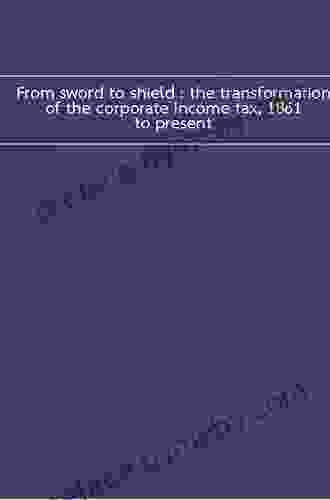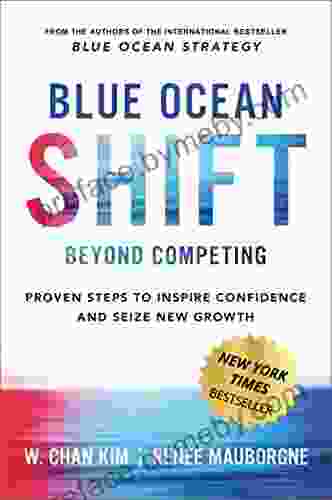The Transformation of the Corporate Income Tax, 1861 to Present

The corporate income tax is a cornerstone of the United States tax system, generating billions of dollars in revenue for the government and significantly impacting businesses and the economy. Its history, however, is far from static, having undergone numerous transformations since its inception in 1861. In this article, we delve into the captivating journey of the corporate income tax, exploring its historical, economic, and policy drivers, and examining its profound impact on businesses and the economy.
4.5 out of 5
| Language | : | English |
| File size | : | 3830 KB |
| Screen Reader | : | Supported |
| Print length | : | 304 pages |
| Lending | : | Enabled |
Antebellum Period (1861-1872)
The roots of the corporate income tax can be traced back to the Civil War era, when the federal government sought new revenue sources to finance the conflict. In 1861, Congress enacted the Revenue Act of 1861, which included a 3% tax on the net income of corporations. However, this tax was short-lived, repealed in 1872 due to its unpopularity and the perception that it unfairly targeted certain industries.
Progressive Era (1894-1913)
The corporate income tax reemerged in the Progressive Era, a period marked by significant economic growth and social reform. In 1894, the Wilson-Gorman Tariff Act reintroduced the corporate income tax at a rate of 2%. This time, the tax gained broader support, as it was seen as a fairer and more equitable way to raise revenue from large corporations.
World War I and the Roaring Twenties (1913-1929)
The outbreak of World War I in 1913 led to a significant expansion of the corporate income tax. The Revenue Act of 1913, passed in the wake of the war, raised the corporate tax rate to 7%, and introduced a new system of graduated rates based on corporate profits. This tax structure remained largely intact throughout the Roaring Twenties, a period of economic prosperity and growth.
The Great Depression and World War II (1929-1945)
The Great Depression of the 1930s significantly impacted the corporate income tax, as corporate profits plummeted and tax revenues declined. The Revenue Act of 1932 raised the corporate tax rate to 13.75%, while subsequent legislation introduced new taxes on corporate surpluses and undistributed profits. World War II further increased the tax burden on corporations, as tax rates rose to unprecedented levels to finance the war effort.
Post-World War II Era (1945-1980)
In the aftermath of World War II, the corporate income tax continued to be a major source of revenue for the government. However, the tax rate began to decline gradually, from 53% in 1946 to 48% in 1964. This trend reflected the belief that lower tax rates would stimulate economic growth and investment.
Reaganomics and Beyond (1981-Present)
The election of Ronald Reagan in 1980 marked a watershed moment in tax policy, with the implementation of "Reaganomics." The Economic Recovery Tax Act of 1981 dramatically reduced the corporate income tax rate from 46% to 34%, and subsequent legislation further lowered it to 21% in 2017. These significant tax cuts were predicated on the belief that they would boost economic growth through increased investment and job creation.
Tax Reform Debates and Challenges
The corporate income tax has been the subject of ongoing debate and reform efforts throughout its history. Concerns about tax avoidance, tax loopholes, and the fairness of the tax system have led to numerous proposals for reform. However, reaching consensus on tax reform has proven to be a difficult task, with opposing viewpoints and political gridlock often impeding progress.
The transformation of the corporate income tax over the past century and a half is a testament to the ever-changing nature of tax policy. From its modest beginnings in 1861 to its present-day complexities, the corporate income tax has played a pivotal role in shaping the United States economy and generating revenue for the government. As we continue to grapple with economic, social, and political challenges, the corporate income tax will undoubtedly remain a topic of debate and reform, as we strive to balance the need for revenue with the desire to promote growth and fairness.
4.5 out of 5
| Language | : | English |
| File size | : | 3830 KB |
| Screen Reader | : | Supported |
| Print length | : | 304 pages |
| Lending | : | Enabled |
Do you want to contribute by writing guest posts on this blog?
Please contact us and send us a resume of previous articles that you have written.
 Book
Book Novel
Novel Page
Page Chapter
Chapter Text
Text Story
Story Genre
Genre Reader
Reader Library
Library Paperback
Paperback E-book
E-book Magazine
Magazine Newspaper
Newspaper Paragraph
Paragraph Sentence
Sentence Bookmark
Bookmark Shelf
Shelf Glossary
Glossary Bibliography
Bibliography Foreword
Foreword Preface
Preface Synopsis
Synopsis Annotation
Annotation Footnote
Footnote Manuscript
Manuscript Scroll
Scroll Codex
Codex Tome
Tome Bestseller
Bestseller Classics
Classics Library card
Library card Narrative
Narrative Biography
Biography Autobiography
Autobiography Memoir
Memoir Reference
Reference Encyclopedia
Encyclopedia Liz Thomas
Liz Thomas Elena Lawson
Elena Lawson Robert Garland
Robert Garland Stephen Rosario Pisani
Stephen Rosario Pisani Ellen Forney
Ellen Forney Victor J Stenger
Victor J Stenger Elly Griffiths
Elly Griffiths Jarvis Jay Masters
Jarvis Jay Masters Emily Lammers
Emily Lammers Javier Zamora
Javier Zamora Eli Brook
Eli Brook Kristen Welch
Kristen Welch John B Boles
John B Boles Ruth Wilshaw
Ruth Wilshaw Eric Berger
Eric Berger Elaine Biech
Elaine Biech Enoch Leffingwell
Enoch Leffingwell Sarah H Parcak
Sarah H Parcak Scott M Madden
Scott M Madden Emma Kertesz
Emma Kertesz
Light bulbAdvertise smarter! Our strategic ad space ensures maximum exposure. Reserve your spot today!

 Branden SimmonsHow One Man Changed Himself to Change the World: An Inspiring Journey of...
Branden SimmonsHow One Man Changed Himself to Change the World: An Inspiring Journey of...
 Jan MitchellUnveiling the Intimate Life of a Complex Man: His Whole Life by Elizabeth Hay
Jan MitchellUnveiling the Intimate Life of a Complex Man: His Whole Life by Elizabeth Hay Ashton ReedFollow ·4.7k
Ashton ReedFollow ·4.7k Eric NelsonFollow ·19.2k
Eric NelsonFollow ·19.2k Chuck MitchellFollow ·6.7k
Chuck MitchellFollow ·6.7k Cormac McCarthyFollow ·6.3k
Cormac McCarthyFollow ·6.3k John Dos PassosFollow ·7.6k
John Dos PassosFollow ·7.6k Preston SimmonsFollow ·18.4k
Preston SimmonsFollow ·18.4k Roy BellFollow ·7.4k
Roy BellFollow ·7.4k Jamie BellFollow ·8.6k
Jamie BellFollow ·8.6k

 Richard Adams
Richard AdamsGame Development with Rust and WebAssembly: A...
Are you passionate...

 David Baldacci
David BaldacciGendered Identity and Aspiration on the Globalized Shop...
: The Convergence of Gender, Identity, and...

 Natsume Sōseki
Natsume SōsekiFresh Eyes On Panama: A Captivating Exploration of a...
Panama, a country often overshadowed by its...

 Adrian Ward
Adrian WardThe Life and Masterworks of J.M.W. Turner: A Timeless...
The Man Behind the Masterpieces ...
4.5 out of 5
| Language | : | English |
| File size | : | 3830 KB |
| Screen Reader | : | Supported |
| Print length | : | 304 pages |
| Lending | : | Enabled |












